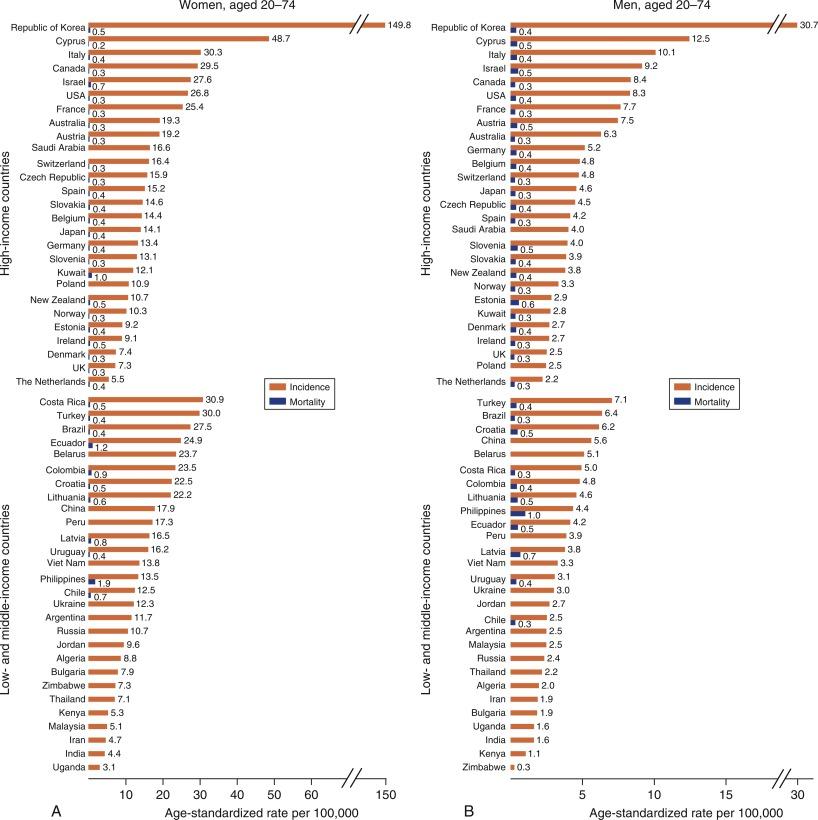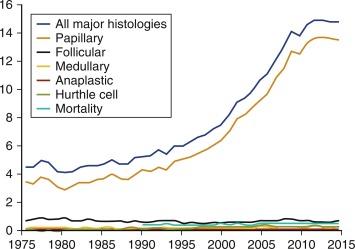Physical Address
304 North Cardinal St.
Dorchester Center, MA 02124
Introduction to [CR] , Differentiated Thyroid Cancer Incidence.
Differentiated thyroid carcinoma (DTC) is the umbrella term that encompasses all malignancies arising from thyroid epithelial follicular cells and is the major form of thyroid carcinoma, comprising > 90% of total thyroid malignancies. This major category is subdivided into three types: papillary thyroid carcinoma (PTC), which comprises 80% to 85% of all thyroid malignancies, and follicular thyroid carcinoma (FTC), which accounts for 10% to 15% of all thyroid malignancies, and hurthle cell carcinoma, which accounts for 3–4% of all thyroid malignancies. The proportions of each vary by country, and rates are affected by diagnostic practices and iodine sufficiency. Overall, papillary thyroid cancer has a good to excellent prognosis and a generally high rate of 10-year survival (90% to 99%); corresponding survival for follicular thyroid cancer is lower, ranging from 55% to 70% and the corresponding rate for hurtle cell carcinoma is about 75%.
PTC has several significant histologic variants: classic, follicular (encapsulated and nonencapsulated), diffuse sclerosing, tall cell/columnar cell, solid, trabecular, and oncocytic, and each varies in aggression and prognosis. PTC has the capability for extrathyroidal extension (ETE) and can involve the adjacent viscera (recurrent laryngeal nerve, larynx, esophagus). It metastasizes through the lymphatics to the regional cervical lymph nodes (central and lateral neck). Follicular thyroid cancer, with a wide range of invasiveness, is less diverse, (3% of all thyroid carcinoma). It spreads hematogenously and exhibits an increased frequency of distant metastasis and decreased incidence of cervical metastasis compared with PTC. In addition, due to its capsular nature, FTC can only be definitively diagnosed via excisional biopsy (in contrast to fine needle aspiration for PTC). Hurthle cell was previously thought to be a variant, but recent genotyping research suggests it is a separate entity.
Thyroid cancer is the most common type of endocrine malignancy, accounting for approximately 2.1% of all cancer diagnoses worldwide. It accounted for 3.8% of new cancers diagnosed in the United States (U.S.) in 2014, making it the ninth most common malignancy in incidence overall. The incidence of DTC has tripled between the 1990's and 2010's in the U.S., with similar trends being seen internationally. Next, we will describe the magnitude of the increase, the potential causal mechanisms, and the strategies that have been taken to address it.
In the U.S. there were approximately 57,000 new cases of thyroid cancer in 2017, and thyroid cancer accounted for approximately 3.5% of all new cancer diagnoses in 2015, the most recent year for which data are available. As of the mid-2010s, thyroid carcinoma was on pace to rise to the fourth most common malignancy in the U.S. by the year 2030 if trends continue.
Incidence rates of thyroid cancer vary dramatically by country; the highest is South Korea (111.3/100,000). There is no predictable pattern to incidence rates; thyroid cancer rates are high in some countries but low in their nearby neighbors, for instance. Incidence rates are also shifting, with countries such as Brazil and China showing recent increases. See Figure 17.1 for details.

In the U.S., the female incidence of DTC (22.3/100,000) is approximately triple that of males (7.7/100,000). International comparisons mirror this proportionality, showing a worldwide age-standardized incidence rate of 6.1/100,000 for women and 1.90/100,000 for men. The median age at diagnosis is younger for thyroid cancer in comparison with most other major types of cancer and is currently 49 years old for females and 54 years old for males.
In the U.S., non-Hispanic white individuals have the highest incidence of DTC, followed by Asian individuals, Hispanic individuals, and non-Hispanic African American individuals. A family history of a first-degree relative with DTC conveys an increased risk of thyroid cancer (odds ratio [OR] 4.1, confidence interval [CI] 1.7 to 9.9 in one study), but the genetic basis of this observation is not well established. True familial nonmedullary thyroid cancer is rare and generally requires that three first degree relatives be affected (see Chapter 30 , Familial Nonmedullary Thyroid Cancer).
DTC within the U.S. was relatively stable before the 1990s at a rate of approximately 5/100,000 overall. Over the ensuing decades, the incidence progressively increased—quite rapidly at first, but slowing in recent years—to an overall age-adjusted annual rate of 15/100,000 in 2015 ( Figure 17.2 ). This increased incidence is almost entirely accounted for by changes in the incidence of PTC (> 90%), which increased from 3.4 to 12.5/100,000 from 1975 to 2009. Of note, although there has been a slight increase in the incidence of FTC, this increase is not significant, and there has also been no significant increase in the incidence of nondifferentiated thyroid cancers (medullary, anaplastic).

Although the number of thyroid cancer cases has clearly escalated, the disease severity of the average diagnosed case has declined. For example, since 1983, the percentage of patients presenting without cervical lymph node metastatic disease metastases (N0) has increased from 66% to 73%, and the percentage of patients found to have pathologic lymphadenopathy (N1) at the time of surgery has decreased from 30% to 23%. Furthermore, the proportion of patients presenting with distant metastatic disease (M1) has decreased from 3.7% to 3.1%. During the same time period, the 10-year relative survival has improved from 95.4% to 98.6%; interestingly, no changes in 10-year relative survival were observed across this time period when stratified by tumor size and stage.
Thyroid cancers of all sizes exhibited an increase over the previous 30 years; the greatest contribution to the overall increase in incidence in both relative and absolute terms was due to malignant tumors < 2 cm in size, which were observed to more than quadruple in incidence from 2 to 9.6/100,000. Within this category, the proportion of papillary thyroid microcarcinoma (PMC) (< 1 cm) increased from 23% to 36%, with tumors 5 mm or less in size increasing from 15% to 22%. Malignant tumors measuring 2.1 to 5 cm also doubled in incidence, from 1.4 to 3.7/100,000, and cancers measuring > 5 cm, although very rare, tripled from 0.2 to 0.7/100,000.
The incidence rate per 100,000 cases of thyroid cancer has risen dramatically in all age groups since 1975, including among adolescents. Rates grew the most in people over age 65, although this is a small segment of the population, so the largest numbers of cases are still in people younger than age 65.
Rates of thyroid cancer differ dramatically across countries, often by degree of human development, although there are notable exceptions. The two largest factors affecting rate differences are iodine availability and access to health care. Where detailed comparisons can be made, developed countries around the world have experienced increases in thyroid cancer incidence similar to the U.S., including Canada, some countries in Europe and Asia, Australia, and parts of South America. The most extreme example is South Korea, where the incidence rate of DTC increased 15-fold between 1993 and 2011, almost entirely due to an increase in PTC, with the incidence rate peaking in women ages 50 to 59 years at around 120/100,000. This increase began after the introduction of a national cancer screening program in 1999, during which thyroid cancer screening, although not recommended or provided, was offered for a small additional fee when patients were attending other screening programs. An estimated 90% of the cancers detected in this time period were asymptomatic. Less dramatic but similar trends have developed in other countries, such as Italy, France, and Australia, where 70% to 80% of detected lesions are estimated to be small and asymptomatic and likely would have been otherwise undetected, and Japan, where this is the case for an estimated 50% of cancers.
In countries with lower resources or levels of human development, there has in general been a much less dramatic increase, and in these countries there is also a greater FTC to PTC ratio as well as more advanced stages at presentation. Multiple studies have demonstrated that iodine deficiency in developing countries leads to an increase in the relative percentage of FTC and a decrease in PTC, with some studies reporting an FTC to PTC ratio that approaches 1:1. The higher proportion of FTC likely contributes to the more advanced stages seen at presentation in these countries. Incidence rates of DTC within more developed countries or countries with higher incomes are more than double in comparison with countries without these characteristics.
Papillary thyroid cancer, the most common type of DTC, is one of the least deadly human cancers with a 10-year disease-specific survival of > 90%. Follicular cancer, as noted earlier, has a significantly worse prognosis with survival rates in the range of 55% to 70%. Although the incidence of papillary cancer has been steadily increasing in the U.S. and developing countries everywhere, the mortality rate has increased only slightly. It is not yet clear whether this shift in mortality is significant.
Follicular cancer mortality has not changed. Since the 1970s, mortality rates in almost all other major countries have either remained stable or decreased, with an average mortality rate from 0.20 to 0.40/100,000 and 0.20 to 0.60/100,000 for women and men, respectively, across all countries.
Become a Clinical Tree membership for Full access and enjoy Unlimited articles
If you are a member. Log in here